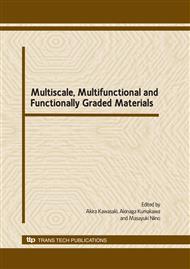p.253
p.259
p.265
p.273
p.279
p.287
p.293
p.299
p.305
Control of the Composition Profile of Tungsten-Copper Functionally Graded Materials for Fusion Technology Application
Abstract:
This work aims to process W-Cu FGM for fusion material applications, in particular plasma facing components (PFC). Currently, PFCs are made by multi-material assembly and rely on tungsten armour tile (high heat flux side) which needs to be cooled by the attachment to a heat sink (Cu-alloys). The interfaces in multi-material assembly are unfavourable for the application (high working temperature, thermal fatigue). The use of FGM can be a new promising way. The aim of this study is to analyze the effect of a composition/grain size variation on the liquid phase migration during liquid phase sintering of FGM, in order to control the final composition profile. Bi-layer materials are processed by powder metallurgy route. W-Cu compositions with 10 and 20wt%Cu and with different W-particle sizes are processed starting with attritor-milled W-CuO powder mixtures which are reduced at 350°C. Analysis of copper liquid phase migration for different composition/grain size associations indicates that the phenomenon is driven by differential sinterability in the gradient. The copper liquid migration depends on the differences in sinterability, on the available liquid and open porosity in the structure beyond the melting point of copper. From these analyses, a way to control the gradient profile of W-Cu structure can be proposed.
Info:
Periodical:
Pages:
279-284
Citation:
Online since:
October 2009
Price:
Сopyright:
© 2010 Trans Tech Publications Ltd. All Rights Reserved
Share:
Citation:


